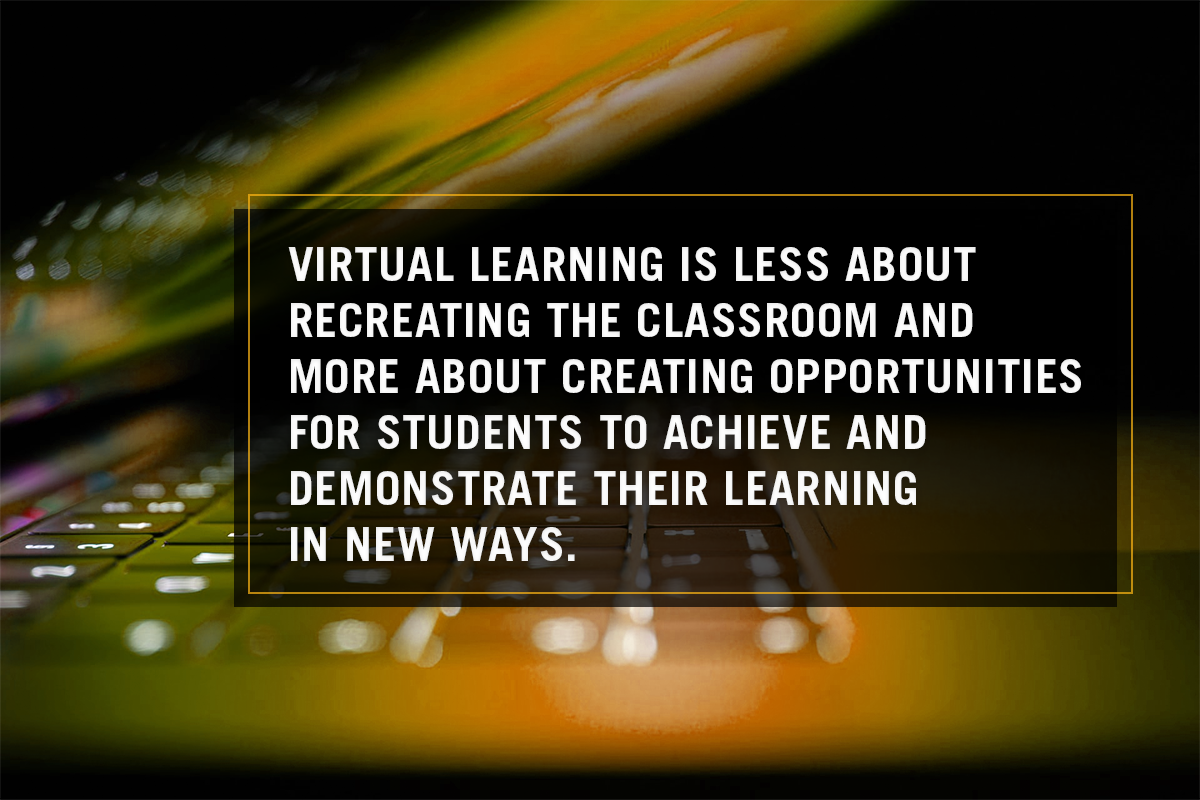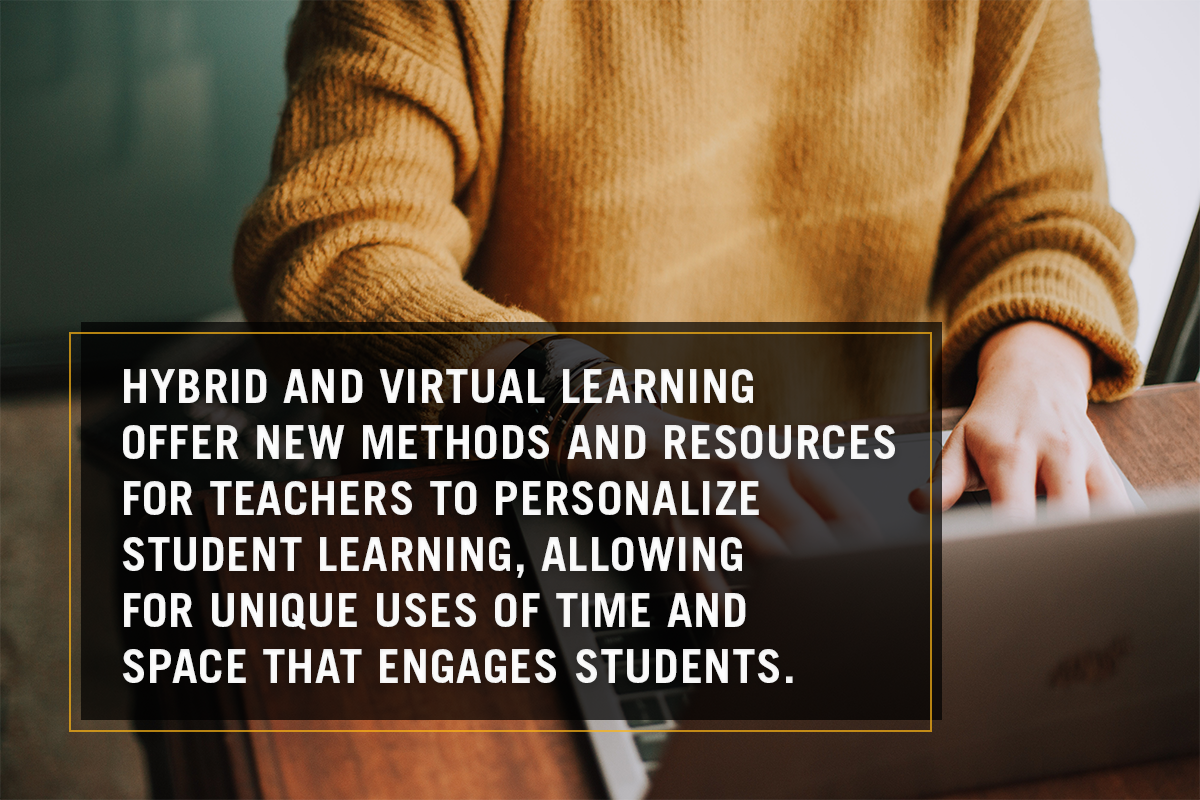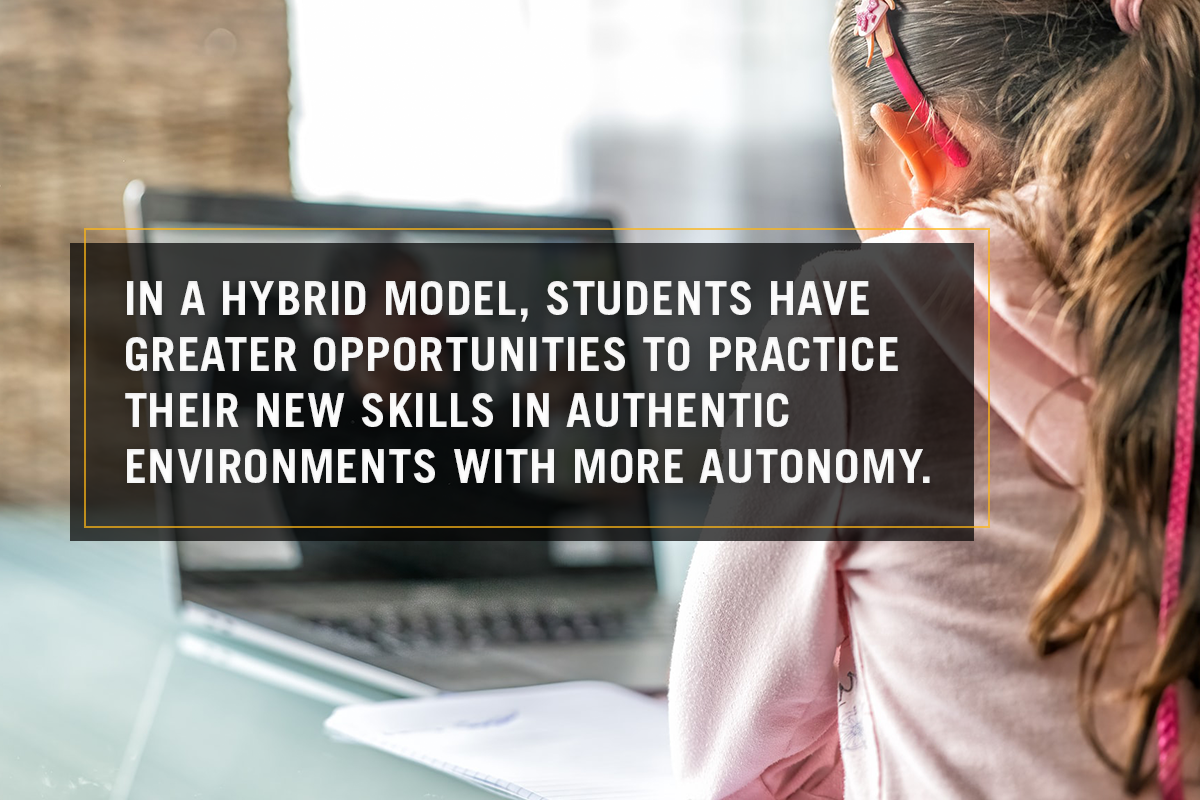
by Dr. Stacey Gonzales
When the pandemic began, schools and districts entered a mad dash to serve their communities. Many students, families, and teachers struggled to keep up with the rapidly changing procedures and new technology. And because of this mass disruption, many parents and policymakers built strong arguments around the “horrors” of virtual and hybrid learning, with several misconceptions emerging as a result.
Emergency virtual and hybrid learning – the likes of which we witnessed during the pandemic – had some drawbacks due to the rush and urgent nature at which it occurred. However, these learning models have existed for decades, which means we can dispel many of the myths that arose during the pandemic.
Myth 1: Virtual and hybrid learning is only for at-risk students.
 Virtual and hybrid learning can be for all students, not just students who have struggled in the traditional school environment. When given more choice over the path, pace, time, or place in their learning, many students thrive. These models offer flexibility that empowers all types of learners to succeed. Teachers can more easily design and personalize instruction by using both traditional and virtual or hybrid learning resources, increasing overall student support. Students who may choose to work and save money for college or other expenses benefit from hybrid and virtual learning models because they place a greater emphasis of agency on the student, allowing for more flexibility in how time is spent. For other students, additional time spent at home with their families may improve learning outcomes or improve home life. For students who need more mobility during instruction, learning from home may provide increased opportunities to stand, move, or walk around. These are just a few examples—benefits from virtual and hybrid learning are as many and varied as the learners and their families.
Virtual and hybrid learning can be for all students, not just students who have struggled in the traditional school environment. When given more choice over the path, pace, time, or place in their learning, many students thrive. These models offer flexibility that empowers all types of learners to succeed. Teachers can more easily design and personalize instruction by using both traditional and virtual or hybrid learning resources, increasing overall student support. Students who may choose to work and save money for college or other expenses benefit from hybrid and virtual learning models because they place a greater emphasis of agency on the student, allowing for more flexibility in how time is spent. For other students, additional time spent at home with their families may improve learning outcomes or improve home life. For students who need more mobility during instruction, learning from home may provide increased opportunities to stand, move, or walk around. These are just a few examples—benefits from virtual and hybrid learning are as many and varied as the learners and their families.
Myth 2: Virtual learning should recreate the classroom online.

Virtual learning is less about recreating the classroom and more about creating opportunities for students to achieve and demonstrate their learning in new ways. Pandemic-style learning that includes daily Zoom lectures is not the norm. The first priority for students and teachers in a virtual learning model is mutually establishing realistic, individual learning goals. In addition to typical formative and summative measurements of student learning, students and teachers can agree on other real-world ways to measure achievement. Virtual learning brings many options to the table; for example, if the learning outcome is to use appropriate communication skills, the student may decide to demonstrate communication skills by recording and sharing a video that includes the key outcomes. The teacher can give virtual feedback on the video and the student can then tweak and revise the video until mastery is achieved.
Myth 3: All students learn better with in-person learning.
 Learning occurs anywhere, anytime. Hybrid and virtual learning offer new methods and resources for teachers to personalize student learning, allowing for unique uses of time and space that engages students. “Traditional” classrooms benefit many students, but they can be limiting due to rigid structures for some learners. Virtual and hybrid learning, on the other hand, are inherently more flexible and allow for innovation. For example, a school using a hybrid format may blend synchronous (at school) and asynchronous (at home) learning. In asynchronous times, students can gain core skills and knowledge at their own pace using digital curriculum. In synchronous time, students can focus on application and critical thinking through project-based learning facilitated by the teacher. Teachers can track individual progress in knowledge and skills acquisition with real-time data to inform instructional decisions and foster meaningful, engaging collaboration and real-world application when students are at school.
Learning occurs anywhere, anytime. Hybrid and virtual learning offer new methods and resources for teachers to personalize student learning, allowing for unique uses of time and space that engages students. “Traditional” classrooms benefit many students, but they can be limiting due to rigid structures for some learners. Virtual and hybrid learning, on the other hand, are inherently more flexible and allow for innovation. For example, a school using a hybrid format may blend synchronous (at school) and asynchronous (at home) learning. In asynchronous times, students can gain core skills and knowledge at their own pace using digital curriculum. In synchronous time, students can focus on application and critical thinking through project-based learning facilitated by the teacher. Teachers can track individual progress in knowledge and skills acquisition with real-time data to inform instructional decisions and foster meaningful, engaging collaboration and real-world application when students are at school.
Myth 4: Hybrid learning is just a way to have fewer students in a classroom at one time.
 Hybrid classrooms allow for more time and individualized attention because of the inherent flexibility the model provides. It emphasizes quality over quantity. Hybrid learning allows the teacher to spend more quality time with students individually or in small groups because at least part of instruction occurs with individualized, digital instruction. These informative experiences give the teacher a clearer picture of the whole student and create the context and understanding needed to design and develop personalized learning outcomes. A hybrid learning model offers students an opportunity to really work closely on the skills they are practicing in the classroom, such as through project-based learning or with real-time feedback from a digital resource. Schools that combine hybrid learning with flexible groupings can bring teams of students together to solve various problems in new and creative ways.
Hybrid classrooms allow for more time and individualized attention because of the inherent flexibility the model provides. It emphasizes quality over quantity. Hybrid learning allows the teacher to spend more quality time with students individually or in small groups because at least part of instruction occurs with individualized, digital instruction. These informative experiences give the teacher a clearer picture of the whole student and create the context and understanding needed to design and develop personalized learning outcomes. A hybrid learning model offers students an opportunity to really work closely on the skills they are practicing in the classroom, such as through project-based learning or with real-time feedback from a digital resource. Schools that combine hybrid learning with flexible groupings can bring teams of students together to solve various problems in new and creative ways.

With hybrid learning, classrooms have changed from places to “acquire learning” to spaces where new “learning ideas can be tested.” In a hybrid model, students have greater opportunities to practice their new skills in authentic environments with more autonomy. While this takes intentional design and planning on the part of the teacher, hybrid learning allows for many benefits that may not be possible with all students in the classroom at the same time.
With the myths dispelled, what’s next?
Keeping up with the constant changes in education due to the pandemic has been difficult. Quick shifts in processes and last-minute changes from school to school, and sometimes from classroom to classroom, became the norm for many. There was no national preparation plan, and stakeholders struggled to make the best decisions they could with both the human and physical resources they had at their immediate disposal. Although some struggled because of “emergency virtual learning” – which is by no means the “gold standard” of learning design – we have seen many benefits for student learning due to hybrid and virtual models. Now is the time to take what we have learned and re-think education so more students can thrive.
About the Author
 Dr. Stacey Gonzales is an educator, leader, and innovator. She is the owner of SG Creative Connections whose mission is dedicated to designing and fostering greater social connections and emotional supports in both face-to-face and online environments. She has dedicated her career to inspiring others as an enthusiastic, curious, thought-leader in the field of education. She values developing authentic personal and professional relationships built on a strong foundation of trust. She is currently the Director of Curriculum & Instruction at Consolidated High School District 230, an award-winning three high school district in the south suburbs of Chicago. She strives daily to inspire, motivate, and engage leadership teams to ensure all 8,000 high school students are well-prepared for their post-secondary experiences. Prior to this role, she served as Director of Innovation for Indian Prairie School District 204, the 4th largest K-12 school district in Illinois. Dr. Gonzales has received awards and recognition for her ability to leverage technology to create meaningful connections. She presents nationally and locally on innovation, leadership, and learning.
Dr. Stacey Gonzales is an educator, leader, and innovator. She is the owner of SG Creative Connections whose mission is dedicated to designing and fostering greater social connections and emotional supports in both face-to-face and online environments. She has dedicated her career to inspiring others as an enthusiastic, curious, thought-leader in the field of education. She values developing authentic personal and professional relationships built on a strong foundation of trust. She is currently the Director of Curriculum & Instruction at Consolidated High School District 230, an award-winning three high school district in the south suburbs of Chicago. She strives daily to inspire, motivate, and engage leadership teams to ensure all 8,000 high school students are well-prepared for their post-secondary experiences. Prior to this role, she served as Director of Innovation for Indian Prairie School District 204, the 4th largest K-12 school district in Illinois. Dr. Gonzales has received awards and recognition for her ability to leverage technology to create meaningful connections. She presents nationally and locally on innovation, leadership, and learning.





